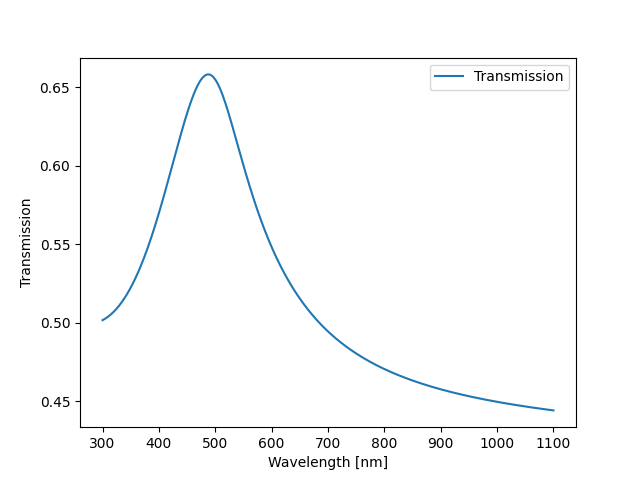Installation and getting started#
Installation#
You can install PyLumerical using pip.
First, ensure that you have the latest pip version:
python -m pip install -U pip
Then, install using:
python -m pip install ansys-lumerical-core
Requirements#
You must have an Ansys Lumerical GUI license to use PyLumerical. For more information, please visit the licensing page on the Ansys Optics website.
In addition, you must also have Lumerical 2022 R1 or later installed on your computer. Upon importing PyLumerical, the autodiscovery function automatically locates the Lumerical installation path. If it fails to do so, you must set the path manually using ansys.lumerical.core.autodiscovery.locate_lumerical_install().
My first PyLumerical project#
The code snippet below provides simple project of using PyLumerical to visualize the transmission of a gold thin film illuminated by a plane wave.
import ansys.lumerical.core as lumapi # Ensure lumapi has already been added to path
import numpy as np
import matplotlib.pyplot as plt
with lumapi.FDTD() as fdtd:
lambda_range = np.linspace(300e-9, 1100e-9, 500)
c=2.99792458e8
f_range = c/lambda_range
au_index = fdtd.getfdtdindex("Au (Gold) - CRC", f_range, np.min(f_range), np.max(f_range)) # Use the getfdtdindex command to obtain the correct complex index for gold
stackRT_result = fdtd.stackrt(np.transpose(au_index), np.array([10e-9]), f_range) # Use the stackrt command to calculate the transmission and reflection
# Visualize using matplotlib
fig, ax = plt.subplots()
ax.plot(lambda_range*1e9, stackRT_result["Ts"], label="Transmission")
ax.set_xlabel("Wavelength [nm]")
ax.set_ylabel("Transmission")
ax.legend()
plt.show()
This simulation returns the following result.

Further resources#
Information on key concepts of PyLumerical.
Reference for the PyLumerical API.
Gallery of examples using PyLumerical.
Recommended examples#
Recommended examples to further build your understanding of PyLumerical and its capabilities.

